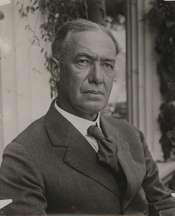William Kent (U.S. Congressman)
| William Kent | |
|---|---|
 | |
| Member of the U.S. House of Representatives from California's 1st district | |
|
In office March 4, 1913 – March 3, 1917 | |
| Preceded by | John E. Raker |
| Succeeded by | Clarence F. Lea |
| Member of the U.S. House of Representatives from California's 2nd district | |
|
In office March 4, 1911 – March 3, 1913 | |
| Preceded by | Duncan E. McKinlay |
| Succeeded by | John E. Raker |
| Personal details | |
| Born |
William Kent 29 April 1868 |
| Died |
13 April 1928 (aged 59) Kentfield, California, U.S. |
| Political party | Progressive Party |
| Spouse(s) | Elizabeth Thacher Kent |
| Alma mater | Yale University |
_in_1916.jpg)
William Kent (March 29, 1864 – March 13, 1928) was an American who served as a United States Congressman representing the State of California. He spearheaded the movement to create the Muir Woods National Monument by donating land to the Federal Government for the Monument.
Biography
Personal life
He was born in Chicago, Illinois on March 29, 1864.[1] His parents, Adaline Elizabeth Dutton and Albert Emmett Kent (A.E. Kent)[1] moved the family to Marin County in California in the year 1871. His father, Albert Emmett Kent had bought 800 acres of valley land that would later become the town Kentfield, California.[2] He was married to Elizabeth Sherman Thacher on February 26, 1890.[1] His wife, Elizabeth Thacher Kent (née Elizabeth Sherman Thacher) was the daughter of Yale professor and administrator Thomas Anthony Thacher. Together they had seven children including sons Sherman Kent (Yale professor and alumni of the US Central Intelligence Agency) and Roger Kent (US politician). His daughter was prominent artist, Adaline Kent.[1] Sherman Day Thacher was his brother-in-law.
Career
He graduated from Yale University in 1887, where he was a member of Skull and Bones.[3]
Upon graduation, Kent returned to Chicago and entered the real estate and livestock businesses. He also became involved in politics, becoming a member of the city council and president of the Municipal Voter's League of Chicago.[4]
In 1907, Kent returned to California and entered the national stage of politics by earning election as a progressive Republican to the 62nd United States Congress. For the 63rd and 64th Congresses he was reelected as an Independent. In total, he served in Congress from March 4, 1911 to March 4, 1917.
In 1916, Kent was the lead sponsor of the legislation in the House of Representatives that created the National Park Service. The similar Senate bill was sponsored by Reed Smoot. The legislation passed the House of Representatives on July 1, 1916, passed the Senate on August 5, and was signed by President Woodrow Wilson on August 25, 1916.[5]
Kent was also heavily involved in local politics; he was one of the major supporters of the creation of the Marin Municipal Water District in 1911, and also backed early efforts for a Golden Gate Bridge. While Kent supported conservation, he also actively worked to promote growth and development in Marin, such as his support for the Mt. Tamalpais & Muir Woods Railway, a renowned Marin County attraction partially funded by his father, Albert Emmett Kent. His wealth as one of the major landowners in the county increased greatly as property values rose.
Following his career in Congress, Kent was appointed to the United States Tariff Commission (now known as the United States International Trade Commission). He served on the Commission from March 21, 1917 to March 31, 1920.
Kent died on March 13, 1928 in Kentfield, California from pneumonia.[4] His remains were cremated in Oakland, California. Survived by wife, five sons, two daughters, and ten grandchildren.[4]
Legacy
Kent was also a philanthropist. Together with his wife, Elizabeth Thacher Kent, he purchased 611 acres (2.5 km²) of one of the last remaining stands of coast redwoods along Redwood Creek north of San Francisco Bay. To protect the redwood grove from development, he donated 295 acres (1.19 km²) to the Federal Government. President Theodore Roosevelt declared the area a national monument in 1908 and suggested naming the monument after Kent. Kent demurred and suggested the grove be named Muir Woods National Monument, after naturalist John Muir. Portraits of the Kent family by artist Herbert A. Collins hang there.
References
- 1 2 3 4 Sherman, Thomas Townsend (1920). Sherman Genealogy Including Families of Essex, Suffolk and Norfolk, England: Some Descendants of the Immigrants, Captain John Sherman, Reverend John Sherman, Edmund Sherman and Samuel Sherman, and the Descendents of Honorable Roger Sherman and Honorable Charles R. Sherman. New York, NY: T. A. Wright. p. 365.
- ↑ "Greenbrae and Kentfield - Overview". Realty Of Marin. Retrieved November 6, 2014.
- ↑ "Obituary Record of Yale Graduates 1927-1928" (PDF). Yale University. 15 September 1928. p. 103. Retrieved March 26, 2011.
- 1 2 3 "Guide to the William Kent Family Papers". Yale University Library. Manuscripts and Archives, Yale University Library. 1961. Retrieved November 6, 2014.
- ↑ Swain, Donald C. (September 1969). "The Founding of the National Park Service". The American West. Palo Alto, CA: American West Publishing Company. VI (5): 6–9.
External links
- "The Legacy of John Muir and William Kent". Cultural History of Muir Woods National Monument. Retrieved June 10, 2005.
- "KENT, William - Biographical Information". Biographal Directory of the United States Congress. Retrieved June 10, 2005.
| United States House of Representatives | ||
|---|---|---|
| Preceded by Duncan E. McKinlay |
Member of the U.S. House of Representatives from California's 2nd congressional district 1911–1913 |
Succeeded by John E. Raker |
| Preceded by John Raker |
Member of the U.S. House of Representatives from California's 1st congressional district 1913–1917 |
Succeeded by Clarence F. Lea |